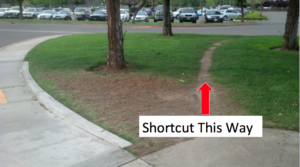More Factoring Methods
Learning Outcomes
- Factor by Grouping
- Identify patterns that result from multiplying two binomials and how they affect factoring by grouping
- Factor a four term polynomial by grouping terms
- Methods for Factoring Trinomials
- Apply an algorithm to rewrite a trinomial as a four term polynomial
- Use factoring by grouping to factor a trinomial
- Use a shortcut to factor trinomials of the form [latex]x^2+bx+c[/latex]
- Factor trinomials of the form [latex]ax^2+bx+c[/latex]
- Recognize where to place negative signs when factoring a trinomial
- Recognize when a polynomial is a difference of squares, and how it would factor as the product of two binomials
 Why Should I Care?
Why Should I Care?[latex]\begin{array}{l}\left(x+4\right)\left(x+2\right)\\=x^{2}+2x+4x+8\\=x^2+6x+8\end{array}[/latex]
Additionally, factoring by grouping is a technique that allows us to factor a polynomial whose terms don't all share a GCF. In the following example, we will introduce you to the technique. Remember, one of the main reasons to factor is because it will help solve polynomial equations.Example
Factor [latex]a^2+3a+5a+15[/latex]Answer: There isn't a common factor between all four terms, so we will group the terms into pairs that will enable us to find a GCF for them. For example, we wouldn't want to group [latex]a^2\text{ and }15[/latex] because they don't share a common factor.
[latex]\left(a^2+3a\right)+\left(5a+15\right)[/latex]
Find the GCF of the first pair of terms.[latex]\begin{array}{l}\,\,\,\,a^2=a\cdot{a}\\\,\,\,\,3a=3\cdot{a}\\\text{GCF}=a\end{array}[/latex]
Factor the GCF, a, out of the first group.[latex]\begin{array}{r}\left(a\cdot{a}+a\cdot{3}\right)+\left(5a+15\right)\\a\left(a+3\right)+\left(5a+15\right)\end{array}[/latex]
Find the GCF of the second pair of terms.[latex]\begin{array}{r}5a=5\cdot{a}\\15=5\cdot3\\\text{GCF}=5\,\,\,\,\,\,\,\end{array}[/latex]
Factor 5 out of the second group.[latex]\begin{array}{l}a\left(a+3\right)+\left(5\cdot{a}+5\cdot3\right)\\a\left(a+3\right)+5\left(a+3\right)\end{array}[/latex]
Notice that the two terms have a common factor [latex]\left(a+3\right)[/latex].[latex]a\left(a+3\right)+5\left(a+3\right)[/latex]
Factor out the common factor [latex]\left(a+3\right)[/latex] from the two terms.[latex]\left(a+3\right)\left(a+5\right)[/latex]
Note how the a and 5 become a binomial sum, and the other factor. This is probably the most confusing part of factoring by grouping.Answer
[latex-display]a^2+3a+5a+15=\left(a+3\right)\left(a+5\right)[/latex-display]- Group the terms of the polynomial into pairs that share a GCF.
- Find the greatest common factor and then use the distributive property to pull out the GCF
- Look for the common binomial between the factored terms
- Factor the common binomial out of the groups, the other factors will make the other binomial
Example
Factor [latex]2x^{2}+4x+5x+10[/latex].Answer: Group terms of the polynomial into pairs.
[latex]\left(2x^{2}+4x\right)+\left(5x+10\right)[/latex]
Factor out the like factor, 2x, from the first group.[latex]2x\left(x+2\right)+\left(5x+10\right)[/latex]
Factor out the like factor, 5, from the second group.[latex]2x\left(x+2\right)+5\left(x+2\right)[/latex]
Look for common factors between the factored forms of the paired terms. Here, the common factor is [latex](x+2)[/latex]. Factor out the common factor, [latex]\left(x+2\right)[/latex], from both terms.[latex]\left(2x+2\right)\left(x+5\right)[/latex]
The polynomial is now factored.Answer
[latex-display]\left(2x+2\right)\left(x+5\right)[/latex-display]Example
Factor [latex]2x^{2}–3x+8x–12[/latex].Answer: Group terms into pairs.
[latex](2x^{2}–3x)+(8x–12)[/latex]
Factor the common factor, x, out of the first group and the common factor, 4, out of the second group.[latex]x\left(2x–3\right)+4\left(2x–3\right)[/latex]
Factor out the common factor, [latex]\left(2x–3\right)[/latex], from both terms.[latex]\left(x+4\right)\left(2x–3\right)[/latex]
Answer
[latex-display]\left(x+4\right)\left(2x-3\right)[/latex-display]Example
Factor [latex]3x^{2}+3x–2x–2[/latex].Answer: Group terms into pairs.
[latex]\left(3x^{2}+3x\right)+\left(-2x-2\right)[/latex]
Factor the common factor 3x out of first group.[latex]3x\left(x+1\right)+\left(-2x-2\right)[/latex]
Factor the common factor [latex]−2[/latex] out of the second group. Notice what happens to the signs within the parentheses once [latex]−2[/latex] is factored out.[latex]3x\left(x+1\right)-2\left(x+1\right)[/latex]
Factor out the common factor, [latex]\left(x+1\right)[/latex], from both terms.[latex]\left(x+1\right)\left(3x-2\right)[/latex]
Answer
[latex-display]\left(x+1\right)\left(3x-2\right)[/latex-display]Example
Factor [latex]7x^{2}–21x+5x–5[/latex].Answer: Group terms into pairs.
[latex]\left(7x^{2}–21x\right)+\left(5x–5\right)[/latex]
Factor the common factor 7x out of the first group.[latex]7x\left(x-3\right)+\left(5x-5\right)[/latex]
Factor the common factor 5 out of the second group.[latex]7x\left(x-3\right)+5\left(x-1\right)[/latex]
The two groups [latex]7x\left(x–3\right)[/latex] and [latex]5\left(x–1\right)[/latex] do not have any common factors, so this polynomial cannot be factored any further.[latex]7x\left(x–3\right)+5\left(x–1\right)[/latex]
Answer
Cannot be factoredFactor Trinomials Part I
In the last section we introduced the technique of factoring by grouping as a means to be able to factor a trinomial. Now we will actually get to the work of starting with a three term polynomial, and rewriting it as a four term polynomial so it can be factored. We will start with factoring trinomials of the form [latex]x^{2}+bx+c[/latex] that don't have a coefficient in front of the [latex]x^2[/latex] term. Remember that when [latex]\left(x+2\right)[/latex] and [latex]\left(x+5\right)[/latex], are multiplied, the result is a four term polynomial and then it is simplified into a trinomial:[latex]\left(x+2\right)\left(x+5\right)=x^2+5x+2x+10=x^2+7x+10[/latex]
Factoring is the reverse of multiplying, so let’s go in reverse and factor the trinomial [latex]x^{2}+7x+10[/latex]. The individual terms [latex]x^{2}[/latex], [latex]7x[/latex], and 10 share no common factors. If we rewrite the middle term as the sum of the two terms [latex]7x=5x+2x[/latex] then we can use the grouping technique:[latex](x^{2}+5x)+(2x+10)[/latex]
Factor each pair: [latex]\begin{array}{l}x\underbrace{\left(x+5\right)}+2\underbrace{\left(x+5\right)}\\\text{common binomial factor}\end{array}[/latex]
Then pull out the common binomial factor: [latex]\left(x+5\right)\left(x+2\right)[/latex]
What would have happened if we had rewritten [latex]7x[/latex] as [latex]6x+x[/latex]?[latex](x^{2}+6x)+(x+10)[/latex]
Factor each pair: [latex]x\left(x+6\right)+1\left(x+10\right)[/latex]
Then we don't have a common factor of [latex]\left(x+5\right)[/latex] like we did before. There is a method to the madness of choosing how to rewrite the middle terms so that you will end up with a common binomial factor. Method to the Madness
Method to the MadnessFactoring Trinomials in the form [latex]x^{2}+bx+c[/latex]
To factor a trinomial in the form [latex]x^{2}+bx+c[/latex], find two integers, r and s, whose product is c and whose sum is b.[latex]\begin{array}{l}r\cdot{s}=c\\\text{ and }\\r+s=b\end{array}[/latex]
Rewrite the trinomial as [latex]x^{2}+rx+sx+c[/latex] and then use grouping and the distributive property to factor the polynomial. The resulting factors will be [latex]\left(x+r\right)[/latex] and [latex]\left(x+s\right)[/latex].| Factors whose product is 6 | Sum of the factors |
|---|---|
| [latex]1\cdot6=6[/latex] | [latex]1+6=7[/latex] |
| [latex]2\cdot3=6[/latex] | [latex]2+3=5[/latex] |
Example
Factor [latex]x^{2}+5x+6[/latex].Answer: Use values from the chart above. Replace [latex]5x[/latex] with [latex]2x+3x[/latex].
[latex]x^{2}+2x+3x+6[/latex]
Group the pairs of terms.[latex]\left(x^{2}+2x\right)+\left(3x+6\right)[/latex]
Factor x out of the first pair of terms[latex]x\left(x+2\right)+\left(3x+6\right)[/latex]
Factor 3 out of the second pair of terms.[latex]x\left(x+2\right)+3\left(x+2\right)[/latex]
Factor out [latex]\left(x+2\right)[/latex].[latex]\left(x+2\right)\left(x+3\right)[/latex]
Answer
[latex-display]\left(x+2\right)\left(x+3\right)[/latex-display]| Factors whose product is [latex]−12[/latex] | Sum of the factors |
|---|---|
| [latex]1\cdot−12=−12[/latex] | [latex]1+−12=−11[/latex] |
| [latex]2\cdot−6=−12[/latex] | [latex]2+−6=−4[/latex] |
| [latex]3\cdot−4=−12[/latex] | [latex]3+−4=−1[/latex] |
| [latex]4\cdot−3=−12[/latex] | [latex]4+−3=1[/latex] |
| [latex]6\cdot−2=−12[/latex] | [latex]6+−2=4[/latex] |
| [latex]12\cdot−1=−12[/latex] | [latex]12+−1=11[/latex] |
Example
Factor [latex]x^{2}+x–12[/latex].Answer: Rewrite the trinomial using the values from the chart above. Use values [latex]r=4[/latex] and [latex]s=−3[/latex].
[latex]x^{2}+4x+−3x–12[/latex]
Group pairs of terms.[latex]\left(x^{2}+4x\right)+\left(−3x–12\right)[/latex]
Factor x out of the first group.[latex]x\left(x+4\right)+\left(-3x-12\right)[/latex]
Factor −3 out of the second group.[latex]x\left(x+4\right)–3\left(x+4\right)[/latex]
Factor out [latex]\left(x+4\right)[/latex].[latex]\left(x+4\right)\left(x-3\right)[/latex]
Answer
[latex-display]\left(x+4\right)\left(x-3\right)[/latex-display]Factoring Tips
Factoring trinomials is a matter of practice and patience. Sometimes, the appropriate number combinations will just pop out and seem so obvious! Other times, despite trying many possibilities, the correct combinations are hard to find. And, there are times when the trinomial cannot be factored. While there is no foolproof way to find the right combination on the first guess, there are some tips that can ease the way.Tips for Finding Values that Work
When factoring a trinomial in the form [latex]x^{2}+bx+c[/latex], consider the following tips. Look at the c term first.- If the c term is a positive number, then the factors of c will both be positive or both be negative. In other words, r and s will have the same sign.
- If the c term is a negative number, then one factor of c will be positive, and one factor of c will be negative. Either r or s will be negative, but not both.
- If the c term is positive and the b term is positive, then both r and s are positive.
- If the c term is positive and the b term is negative, then both r and s are negative.
- If the c term is negative and the b term is positive, then the factor that is positive will have the greater absolute value. That is, if [latex]|r|>|s|[/latex], then r is positive and s is negative.
- If the c term is negative and the b term is negative, then the factor that is negative will have the greater absolute value. That is, if [latex]|r|>|s|[/latex], then r is negative and s is positive.
| Trinomial | [latex]x^{2}+7x+10[/latex] | [latex]x^{2}+5x+6[/latex] | [latex]x^{2}+x-12[/latex] |
|---|---|---|---|
| r and s values | [latex]r=+5,s=+2[/latex] | [latex]r=+2,s=+3[/latex] | [latex]r=+4,s=–3[/latex] |
| Factored form | [latex]\left(x+5\right)\left(x+2\right)[/latex] | [latex]\left(x+2\right)\left(x+3\right)[/latex] | [latex](x+4)(x–3)[/latex] |
The Shortcut
Notice that in each of the examples above, the r and s values are repeated in the factored form of the trinomial. So what does this mean? It means that in trinomials of the form [latex]x^{2}+bx+c[/latex] (where the coefficient in front of [latex]x^{2}[/latex] is 1), if you can identify the correct r and s values, you can effectively skip the grouping steps and go right to the factored form. For those of you that like shortcuts, let's look at some examples where we use this idea. Shortcut This Way
Shortcut This Way[latex]\left(x+r\right)\left(x+s\right)\text{ OR }\left(x+s\right)\left(x+r\right)[/latex]
Example
Factor: [latex]y^2+6y-27[/latex]Answer: Find r and s:
| Factors whose product is -27 | Sum of the factors |
|---|---|
| [latex]1\cdot{-27}=-27[/latex] | [latex]1-27=-26[/latex] |
| [latex]3\cdot{-9}=-27[/latex] | [latex]3-9=-6[/latex] |
| [latex]-3\cdot{9}=-27[/latex] | [latex]-3+9=6[/latex] |
[latex]\begin{array}{l}r=-3\\s=9\end{array}[/latex]
It helps to start by writing two empty sets of parentheses:[latex]\left(\,\,\,\,\,\,\,\,\,\,\,\,\right)\left(\,\,\,\,\,\,\,\,\,\,\,\,\right)[/latex]
The squared term is y, so we will place a y in each set of parentheses:
[latex]\left(y\,\,\,\,\,\,\,\,\right)\left(y\,\,\,\,\,\,\,\,\right)[/latex]
Now we can fill in the rest of each binomial with the values we found for r and s.
[latex]\left(y-3\right)\left(y+9\right)[/latex]
Note how we kept the sign on each of the values. The nice thing about factoring is you can check your work. Multiply the binomials together to see if you did it correctly.
[latex]\begin{array}{l}\left(y-3\right)\left(y+9\right)\\=y^2+9y-3y-27\\=y^2+6y-27\end{array}[/latex]
Answer
[latex-display]\left(y-3\right)\left(y+9\right)[/latex-display]Example
Factor: [latex]-m^2+16m-48[/latex]Answer: There is a negative in front of the squared term, so we will factor out a negative one from the whole trinomial first. Remember, this boils down to changing the sign of all the terms:
[latex]-m^2+16m-48=-1\left(m^2-16m+48\right)[/latex]
Now we can factor [latex]\left(m^2-16m+48\right)[/latex] by finding r and s. Note that b is negative, and c is positive so we are probably looking for two negative numbers:
| Factors whose product is 48 | Sum of the factors |
|---|---|
| [latex]-1\cdot{-48}=48[/latex] | [latex]-1-48=-49[/latex] |
| [latex]-2\cdot{-12}=48[/latex] | [latex]-2-12=-14[/latex] |
| [latex]-3\cdot{-16}=-48[/latex] | [latex]-3-16=-19[/latex] |
| [latex]-4\cdot{-12}=-48[/latex] | [latex]-4-12=-16[/latex] |
There are more factors whose product is 48, but we have found the ones that sum to -16, so we can stop.
[latex]\begin{array}{l}r=-4\\s=-12\end{array}[/latex]
Now we can fill in each binomial with the values we found for r and s, make sure to use the correct variable!
[latex]\left(m-4\right)\left(m-12\right)[/latex]
We are not done yet, remember that we factored out a negative sign in the first step. We need to remember to include that.
[latex]-1\left(m-4\right)\left(m-12\right)[/latex]
Answer
[latex-display]-m^2+16m-48=-1\left(m-4\right)\left(m-12\right)[/latex-display]Factor Trinomials Part II
The next goal is for you to be comfortable with recognizing where to place negative signs, and whether a trinomial can even be factored. Additionally, we will explore one special case to look out for at the end of this page. Not all trinomials look like [latex]x^{2}+5x+6[/latex], where the coefficient in front of the [latex]x^{2}[/latex] term is 1. In these cases, your first step should be to look for common factors for the three terms.| Trinomial | Factor out Common Factor | Factored |
|---|---|---|
| [latex]2x^{2}+10x+12[/latex] | [latex]2(x^{2}+5x+6)[/latex] | [latex]2\left(x+2\right)\left(x+3\right)[/latex] |
| [latex]−5a^{2}−15a−10[/latex] | [latex]−5(a^{2}+3a+2)[/latex] | [latex]−5\left(a+2\right)\left(a+1\right)[/latex] |
| [latex]c^{3}–8c^{2}+15c[/latex] | [latex]c\left(c^{2}–8c+15\right)[/latex] | [latex]c\left(c–5\right)\left(c–3\right)[/latex] |
| [latex]y^{4}–9y^{3}–10y^{2}[/latex] | [latex]y^{2}\left(y^{2}–9y–10\right)[/latex] | [latex]y^{2}\left(y–10\right)\left(y+1\right)[/latex] |
Example
Factor [latex]3x^{3}–3x^{2}–90x[/latex].Answer: Since 3 is a common factor for the three terms, factor out the 3.
[latex]3\left(x^{3}–x^{2}–30x\right)[/latex]
x is also a common factor, so factor out x.[latex]3x\left(x^{2}–x–30\right)[/latex]
Now you can factor the trinomial [latex]x^{2}–x–30[/latex]. To find r and s, identify two numbers whose product is [latex]−30[/latex] and whose sum is [latex]−1[/latex]. The pair of factors is [latex]−6[/latex] and [latex]5[/latex]. So replace [latex]–x[/latex] with [latex]−6x+5x[/latex].[latex]3x\left(x^{2}–6x+5x–30\right)[/latex]
Use grouping to consider the terms in pairs.[latex]3x\left[\left(x^{2}–6x\right)+\left(5x–30\right)\right][/latex]
Factor x out of the first group and factor 5 out of the second group.[latex]3x\left[\left(x\left(x–6\right)\right)+5\left(x–6\right)\right][/latex]
Then factor out [latex]x–6[/latex].[latex]3x\left(x–6\right)\left(x+5\right)[/latex]
Answer
[latex-display]3x\left(x–6\right)\left(x+5\right)[/latex-display]Factoring Trinomials in the form [latex]ax^{2}+bx+c[/latex]
To factor a trinomial in the form [latex]ax^{2}+bx+c[/latex], find two integers, r and s, whose sum is b and whose product is ac.[latex]\begin{array}{l}r\cdot{s}=a\cdot{c}\\r+s=b\end{array}[/latex]
Rewrite the trinomial as [latex]ax^{2}+rx+sx+c[/latex] and then use grouping and the distributive property to factor the polynomial.| Factors whose product is 24 | Sum of the factors |
|---|---|
| [latex]1\cdot24=24[/latex] | [latex]1+24=25[/latex] |
| [latex]2\cdot12=24[/latex] | [latex]2+12=14[/latex] |
| [latex]3\cdot8=24[/latex] | [latex]3+8=11[/latex] |
| [latex]4\cdot6=24[/latex] | [latex]4+6=10[/latex] |
Example
Factor [latex]6z^{2}+11z+4[/latex].Answer: Rewrite the middle term, [latex]11z[/latex], as [latex]3z + 8z[/latex] (from the chart above.)
[latex]6z^{2}+3z+8z+4[/latex]
Group pairs. Use grouping to consider the terms in pairs.[latex]\left(6z^{2}+3z\right)+\left(8z+4\right)[/latex]
Factor 3z out of the first group and 4 out of the second group.[latex]3z\left(2z+1\right)+4\left(2z+1\right)[/latex]
Factor out [latex]\left(2z+1\right)[/latex].[latex]\left(2z+1\right)\left(3z+4\right)[/latex]
Answer
[latex-display]\left(2z+1\right)\left(3z+4\right)[/latex-display]Example
Factor [latex]−4h^{2}+11h+3[/latex]Answer: Factor [latex]−1[/latex] out of the trinomial. Notice that the signs of all three terms have changed.
[latex]−1\left(4h^{2}–11h–3\right)[/latex]
To factor the trinomial, you need to figure out how to rewrite [latex]−11h[/latex]. The product of [latex]rs=4\cdot−3=−12[/latex], and the sum of [latex]rs=−11[/latex].| [latex]r\cdot{s}=−12[/latex] | [latex]r+s=−11[/latex] |
| [latex]−12\cdot1=−12[/latex] | [latex]−12+1=−11[/latex] |
| [latex]−6\cdot2=−12[/latex] | [latex]−6+2=−4[/latex] |
| [latex]−4\cdot3=−12[/latex] | [latex]−4+3=−1[/latex] |
[latex]−1\left(4h^{2}–12h+1h–3\right)[/latex]
Group terms.[latex]−1\left[\left(4h^{2}–12h\right)+\left(1h–3\right)\right][/latex]
Factor out 4h from the first pair. The second group cannot be factored further, but you can write it as [latex]+1\left(h–3\right)[/latex] since [latex]+1\left(h–3\right)=\left(h–3\right)[/latex]. This helps with factoring in the next step.[latex]−1\left[4h\left(h–3\right)+1\left(h–3\right)\right][/latex]
Factor out a common factor of [latex]\left(h–3\right)[/latex]. Notice you are left with [latex]\left(h–3\right)\left(4h+1\right)[/latex]; the [latex]+1[/latex] comes from the term [latex]+1\left(h–3\right)[/latex] in the previous step.[latex]−1\left[\left(h–3\right)\left(4h+1\right)\right][/latex]
Answer
[latex-display]−1\left(h–3\right)\left(4h+1\right)[/latex-display]Difference of Squares
We would be remiss if we failed to introduce one more type of polynomial that can be factored. This polynomial can be factored into two binomials but has only two terms. Let's start from the product of two binomials to see the pattern. Given the product of two binomials: [latex]\left(x-2\right)\left(x+2\right)[/latex], if we multiply them together, we lose the middle term that we are used to seeing as a result.Multiply:
[latex]\begin{array}{l}\left(x-2\right)\left(x+2\right)\\\text{}\\=x^2-2x+2x-2^2\\\text{}\\=x^2-2^2\\\text{}\\=x^2-4\end{array}[/latex]
The polynomial [latex]x^2-4[/latex] is called a difference of squares because teach term can be written as something squared. A difference of squares will always factor in the following way:Factor a Difference of Squares
Given [latex]a^2-b^2[/latex], it's factored form will be [latex]\left(a+b\right)\left(a-b\right)[/latex]Find the factors of [latex]a\cdot{c}[/latex] whose sum is b, in this case, 0:
| Factors of [latex]−4[/latex] | Sum of the factors |
|---|---|
| [latex]1\cdot-4=−4[/latex] | [latex]1-4=−3[/latex] |
| [latex]2\cdot−2=−4[/latex] | [latex]2-2=0[/latex] |
| [latex]-1\cdot4=−4[/latex] | [latex]-1+4=3[/latex] |
Example
Factor [latex]x^{2}–4[/latex].Answer: Rewrite [latex]0x[/latex] as [latex]−2x+2x[/latex].
[latex]\begin{array}{l}x^{2}+0x-4\\x^{2}-2x+2x-4\end{array}[/latex]
Group pairs.[latex]\left(x^{2}–2x\right)+\left(2x–4\right)[/latex]
Factor x out of the first group. Factor 2 out of the second group.[latex]x\left(x–2\right)+2\left(x–2\right)[/latex]
Factor out [latex]\left(x–2\right)[/latex].[latex]\left(x–2\right)\left(x+2\right)[/latex]
Answer
[latex-display]\left(3x–2\right)\left(3x+2\right)[/latex-display]Summary
When a trinomial is in the form of [latex]ax^{2}+bx+c[/latex], where a is a coefficient other than 1, look first for common factors for all three terms. Factor out the common factor first, then factor the remaining simpler trinomial. If the remaining trinomial is still of the form [latex]ax^{2}+bx+c[/latex], find two integers, r and s, whose sum is b and whose product is ac. Then rewrite the trinomial as [latex]ax^{2}+rx+sx+c[/latex] and use grouping and the distributive property to factor the polynomial. When [latex]ax^{2}[/latex] is negative, you can factor [latex]−1[/latex] out of the whole trinomial before continuing. A difference of squares [latex]a^2-b^2[/latex] will factor in this way: [latex]\left(a+b\right)\left(a-b\right)[/latex].Summary
Trinomials in the form [latex]x^{2}+bx+c[/latex] can be factored by finding two integers, r and s, whose sum is b and whose product is c. Rewrite the trinomial as [latex]x^{2}+rx+sx+c[/latex] and then use grouping and the distributive property to factor the polynomial.Licenses & Attributions
CC licensed content, Original
- Screenshot: Why Should I Care?. Provided by: Lumen Learning License: CC BY: Attribution.
- Revision and Adaptation. Provided by: Lumen Learning License: CC BY: Attribution.
- Screenshot: Method to the Madness. Provided by: Lumen Learning License: CC BY: Attribution.
- Image: Shortcut This Way. Provided by: Lumen Learning License: CC BY: Attribution.
CC licensed content, Shared previously
- Ex 2: Intro to Factor By Grouping Technique. Authored by: James Sousa (Mathispower4u.com) for Lumen Learning. License: CC BY: Attribution.
- Ex 1: Intro to Factor By Grouping Technique Mathispower4u . Authored by: James Sousa (Mathispower4u.com) . License: CC BY: Attribution.
- Unit 12: Factoring, from Developmental Math: An Open Program. Provided by: Monterey Institute of Technology and Education Located at: https://www.nroc.org/. License: CC BY: Attribution.
- Ex 1: Factor a Quadratic Expression Using Grouping When a = 1 . Authored by: James Sousa (Mathispower4u.com) for Lumen Learning. License: CC BY: Attribution.
- Factor a Trinomial Using the Shortcut Method - Form x^2+bx+c. Authored by: James Sousa (Mathispower4u.com) . License: CC BY: Attribution.
- Ex: Factor a Difference of Squares. Authored by: James Sousa (Mathispower4u.com) . License: CC BY: Attribution.
